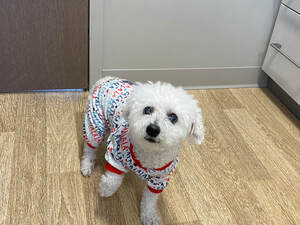|
Proper Paws' Judy Bernard on Training Tips for Pandemic Puppy Owners (part 3 of 3)
While the idea of returning to our pre-pandemic lives might be exciting for us humans, we must warn you that the road will be rocky for many pets. This will be particularly true for puppies who have only known a world where they are surrounded by their beloved humans. We humans have been home all the time: not going into work, not vacationing, not visiting friends & family, and not going out to dinner. As we receive our vaccines and begin to venture out, our puppies might have a problem. Fortunately, Judy has thoughts on how we can prep our puppies and dogs for the changes coming their way.  Stella by Starlight and puppies like her have been enjoying lots of time with their humans Stella by Starlight and puppies like her have been enjoying lots of time with their humans Katherine: How do you expect puppies to react as their owners begin to venture out of the house without them? In some cases, for the first time in these puppies’ lives? Judy: Separation issues are bound to happen in a time where we are all working from home and our dogs have gotten used to us being here. Let’s face it: we are all pack animals and having our pack around us all the time is very comforting. That said, reality will return and our puppies and dogs will need to get used to us NOT being home 24/7. The key to making sure they are as unaffected by this changes as possible is to start practicing now. Katherine: How should we practice leaving our puppies and dogs alone? Judy: Here are some quick thoughts on how to make your dog’s transition back to ‘normalcy’ as uneventful as possible. Set up a regular routine where you leave the house without your dog. Try to do this as close to your expected normal time as possible and do it every day. Start with short trips away, like to check your mailbox, and extend the trips as your dog gains comfort and confidence. Set your dog up for success as you train them to be alone. Make sure the dog’s physical and mental needs are taken care of before you leave. Feed and exercise the dog and make sure they have eliminated. When you leave, make sure your pet is in a puppy/dog proof environment. A crate is preferred for young puppies who may eliminate, chew things, or otherwise get into trouble. You may need to revisit crate training prior to starting this routine if your puppy/dog isn’t comfortable being in the crate. Give them a stuffed Kong or other safe high value treat to work on while you are gone. Make leaving and coming as much of a non-event as possible and do it multiple times a day. The more practice the dog gets with short, happy absences the better.  Suzie getting mentally prepared for a little more alone time Suzie getting mentally prepared for a little more alone time Katherine: What can owners do if their dog doesn’t react well to being left along? Judy: If the dog reacts poorly, stop and re-evaluate your plan. You may have to start with smaller steps, like leaving the room but not the house to begin with. It may help to use an automated food delivery device to associate your leaving with a steady flow of food. If your dog will not eat or engage with a high value treat (like a stuffed Kong) in your absence this is a sign of heightened stress and anxiety. In the case of extreme anxiety, fear, or stress you may need to consult with your veterinarian and/or a behavior professional for a behavior modification plan. Signs of extreme anxiety/stress include:
Comments are closed.
|
|
OFFICE HOURS:
Monday-Friday: 8:00 am to 6:00 pm Saturday: 8:00 am to 12:00 pm |
CONTACT INFORMATION:
Concord Animal Hospital 245 Baker Avenue Concord, MA 01742 Phone: (978) 369-3503 Fax: (978) 371-9748 [email protected] |
JOIN OUR PACK!
Sign up for our monthly newsletter, the Paw Press for hospital news, pet care tips and cute pet photos! |
Copyright © 2022

